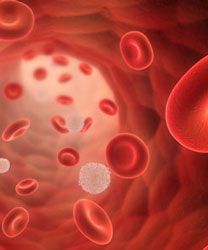Lenalidomide Consolidation OS Plateau Intrigues in CLL
Induction therapy with fludarabine and rituximab followed by lenalidomide consolidation therapy (FR-L) demonstrated a distinct plateau in overall survivalbeyond that seen with FR or FR plus cyclophosphamide (FCR) alone for patients with symptomatic, untreated non-del(11q) chronic lymphocytic leukemia.
cll

Induction therapy with fludarabine and rituximab followed by lenalidomide consolidation therapy (FR-L) demonstrated a distinct plateau in overall survival (OS) beyond that seen with FR or FR plus cyclophosphamide (FCR) alone for patients with symptomatic, untreated non-del(11q) chronic lymphocytic leukemia (CLL), according to findings from CALGB 10404 presented at the 2017 ASCO Annual Meeting.
At the time of the analysis of the phase II study, median OS was not reached in any of the arms, with similar rates of survival seen at 1, 2, and 3 years. However, beyond month 41, deaths continued to occur in the FR and FCR arms but not for those treated with FR+L, representing a unique plateau of the survival curve. Progression-free survival (PFS) was superior with FR+L and FCR compared with FR alone.
"Lenalidomide consolidation appears to increase long-term survival, demonstrated by an unusual overall survival plateau that warrants further study," said lead author Amy S. Ruppert, MAS, a biostatisician at The Ohio State University. "FR+L and FCR have superior PFS compared with FR. Both met the protocol defined primary endpoint."
In the study, 342 patients with non-del(11q) CLL were randomized to FR (n = 123), FR+L (n = 109), or FCR (n = 110). Induction therapy with FR and FCR was given for 6 months with lenalidomide added as consolidation in month 10 in the FR+L group. Those with del(11q22.3) in more than 20% of cells were enrolled into a separate portion of the study.
In the FR and FR+L groups, patients received fludarabine at 25 mg/m2 on days 1 to 5 of each cycle. In the FCR group, fludarabine was given on day 1 to 3 at the 25 mg/m2 dose. In the FR and FR+L groups, rituximab was given at 50 mg/m2 on day 1 and then escalated to 325 mg/m2 on day 3 and then to 375 mg/m2 on day 5 for the first cycle. In subsequent cycles, it was administered on day 1 at 375 mg/m2. In the FCR group, rituximab was given at 50 mg/m2 on day 1 followed by 325 mg/m2 on day 2 then 500 mg/m2 on day 1 of subsequent cycles. Lenalidomide was given for 6 months at 5 mg on days 1 to 21 for the first 28-day cycle followed by 10 mg on days 1 to 21 for the remaining 5 cycles.
The median age of patients was 61 years and nearly half of patients had Rai stage III/IV disease. The study included those with 17p deletions (approximately 10%) and those with 13q deletions (range, 33%-47%). Nearly a quarter of patients in each arm had lymph nodes >5 cm.
The objective response rate (ORR) was 75% in the FR group and 69% and 71% in the FR+L and FCR groups, respectively. The ORR included complete responses for 32%, 33%, and 51% of patients, in the FR, FR+L, and FCR groups, respectively. After 2 years, 71% of patients remained alive and progression-free in the FR+L group (90% CI, 63%-78%). The 2-year progression-free survival (PFS) rates were 64% (90% CI, 57%-71%) and 74% (66%-80%) in the FR and FCR arms, respectively.
The median PFS was 66 months with FR+L (95% CI, 45 to not reached) and 78 months with FCR (95% CI, 58 to not reached). When compared with FR alone, which induced a median PFS of 43 months (95% CI, 33-50), there was a significant improvement in PFS in the FR+L (P = .03) and FCR (P <.01) groups. This improvement was strengthened in multivariable analyses (FR+L vs FR; HR, 0.58; 95% CI, 0.37-0.91; P = .02).
In a multivariable analysis of OS, at 24 months FR+L was associated with a 28% reduction in the risk of death versus FR alone (HR, 0.72; 95% CI, 0.29-1.83). By month 48, this had improved to a statistically significant 73% reduction in the risk of death (HR, 0.27; 95% CI, 0.10-0.70). FCR was not associated with a statistically significant improvement in OS versus FR alone.
Each regimen was associated with similar rates of grade ≥3 hematologic adverse events (AEs), with 79% of patients having an event with FR alone and 82% and 85% having an event in the FR+L and FCR groups, respectively. There were more grade ≥3 non-hematologic AEs with FR+L (61%) and FCR (63%) compared with FR alone (48%).
"Brief lenalidomide consolidation after chemoimmunotherapy is acceptably tolerated," Ruppert concluded. Moreover, she added that treatment assignment based on central cytogenetics was feasible and could become common practice in large, multicenter studies.
Ruppert AS, Byrd JC, Heerema NA, et al. A genetic risk-stratified, randomized phase 2 intergroup study of fludarabine/antibody combinations in symptomatic, untreated chronic lymphocytic leukemia (CLL): Results from Cancer and Leukemia Group B (CALGB) 10404 (Alliance). J Clin Oncol. 2017;35(suppl; abstr 7503).
<<<
View more from the 2017 ASCO Annual Meeting



